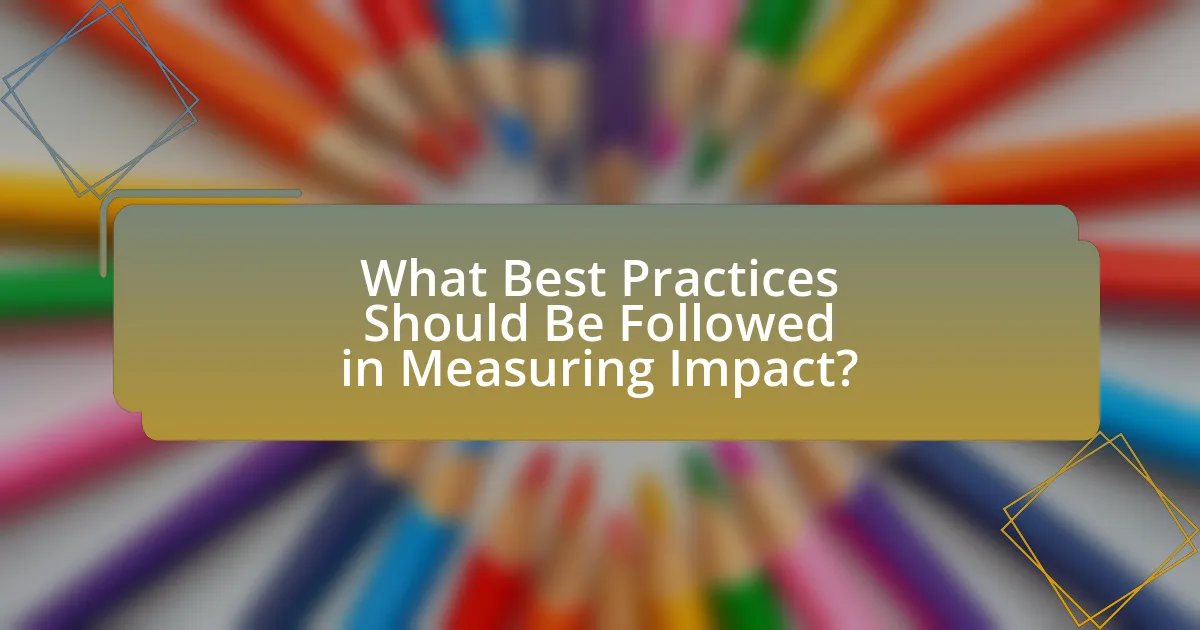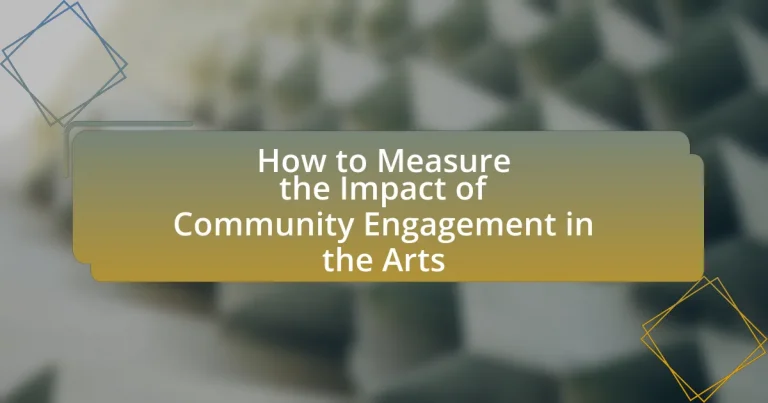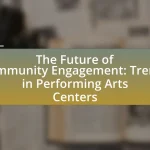The article focuses on measuring the impact of community engagement in the arts, highlighting its significance in enhancing social cohesion and individual well-being. It defines community engagement as the active participation of individuals in artistic activities that foster collaboration and cultural exchange. Key elements include participation, collaboration, accessibility, and cultural relevance, which contribute to increased community pride and improved quality of life. The article also discusses various types of community engagement, the role of local artists, and the importance of utilizing both qualitative and quantitative methods for effective impact measurement. Additionally, it addresses challenges organizations face in this process and offers best practices for overcoming these obstacles, ultimately emphasizing the value of structured evaluation in optimizing community engagement initiatives.

What is the Impact of Community Engagement in the Arts?
Community engagement in the arts significantly enhances social cohesion and fosters a sense of belonging among participants. Research indicates that when communities actively participate in artistic endeavors, they experience increased collaboration and communication, which strengthens community ties. For instance, a study by the National Endowment for the Arts found that community-based arts programs lead to improved civic engagement, with 75% of participants reporting a greater connection to their community. Additionally, community engagement in the arts can boost individual well-being, as evidenced by findings from the Arts Council England, which reported that individuals involved in arts activities experience higher levels of life satisfaction and mental health benefits.
How is community engagement defined in the context of the arts?
Community engagement in the context of the arts is defined as the active participation of individuals and groups in artistic activities that foster collaboration, creativity, and cultural exchange. This engagement often involves artists, community members, and organizations working together to create, share, and experience art, thereby enhancing social cohesion and cultural vitality. Research indicates that such engagement can lead to increased community pride and improved quality of life, as evidenced by studies showing that communities with strong arts programs report higher levels of social interaction and community involvement.
What are the key elements of community engagement in the arts?
The key elements of community engagement in the arts include participation, collaboration, accessibility, and cultural relevance. Participation involves active involvement of community members in artistic activities, which fosters a sense of ownership and connection to the arts. Collaboration refers to partnerships between artists, organizations, and community members, enhancing the diversity of perspectives and resources. Accessibility ensures that arts programs are available to all community members, regardless of socioeconomic status, thereby promoting inclusivity. Cultural relevance emphasizes the importance of reflecting the community’s values, traditions, and identities in artistic expressions, which strengthens community ties and engagement. These elements are supported by research indicating that community-driven arts initiatives lead to increased social cohesion and improved well-being among participants.
Why is community engagement important for the arts?
Community engagement is important for the arts because it fosters inclusivity and enhances the relevance of artistic expressions within society. Engaging the community allows artists and organizations to understand diverse perspectives, ensuring that the art produced resonates with a broader audience. Research indicates that community-driven art initiatives can increase participation rates by up to 50%, demonstrating a direct correlation between engagement and audience growth. Furthermore, studies show that communities with active arts engagement experience improved social cohesion and well-being, as evidenced by the National Endowment for the Arts, which highlights that arts participation can lead to increased civic engagement and community pride.
What are the different types of community engagement in the arts?
Different types of community engagement in the arts include participatory art projects, community-based performances, workshops, and collaborative exhibitions. Participatory art projects involve community members in the creation process, fostering a sense of ownership and connection to the artwork. Community-based performances often showcase local talent and narratives, enhancing cultural representation. Workshops provide educational opportunities, allowing participants to develop artistic skills while engaging with the arts. Collaborative exhibitions bring together diverse artists and community members to create a shared artistic experience, promoting dialogue and understanding. These forms of engagement have been shown to enhance social cohesion and cultural vitality within communities.
How do participatory arts projects differ from traditional arts initiatives?
Participatory arts projects differ from traditional arts initiatives primarily in their emphasis on community involvement and collaboration. While traditional arts initiatives often focus on the creation and presentation of art by established artists for passive audiences, participatory arts projects actively engage community members in the artistic process, allowing them to contribute their ideas, skills, and experiences. This approach fosters a sense of ownership and empowerment among participants, as evidenced by studies showing that community engagement in the arts can enhance social cohesion and individual well-being. For instance, research published in the Journal of Community Engagement and Scholarship highlights that participatory arts initiatives lead to increased community pride and improved mental health outcomes among participants.
What role do local artists play in community engagement?
Local artists play a crucial role in community engagement by fostering connections among residents and enhancing cultural identity. They create art that reflects local experiences, which encourages dialogue and participation within the community. For instance, community murals and public performances often involve collaboration with residents, leading to a sense of ownership and pride in shared spaces. Research indicates that communities with active local artists experience increased social cohesion and civic participation, as evidenced by a study from the National Endowment for the Arts, which found that arts engagement correlates with higher levels of community involvement and volunteerism.
How can we assess the impact of community engagement in the arts?
To assess the impact of community engagement in the arts, one can utilize quantitative and qualitative evaluation methods. Quantitative methods include surveys measuring participation rates, attendance figures, and demographic data, which provide statistical insights into community involvement. Qualitative methods involve interviews and focus groups that gather personal narratives and experiences, revealing deeper emotional and social impacts. Research by the National Endowment for the Arts indicates that community engagement in the arts can lead to increased social cohesion and improved mental health outcomes, demonstrating the tangible benefits of such initiatives.
What metrics are commonly used to measure impact?
Common metrics used to measure impact in community engagement in the arts include attendance figures, participant demographics, and qualitative feedback. Attendance figures provide quantitative data on how many individuals engage with arts programs, while participant demographics help assess the diversity and reach of these programs. Qualitative feedback, gathered through surveys or interviews, offers insights into participants’ experiences and perceived value of the engagement. These metrics collectively enable organizations to evaluate the effectiveness and reach of their community engagement efforts in the arts.
How do qualitative and quantitative methods differ in measuring impact?
Qualitative and quantitative methods differ significantly in measuring impact, primarily in their approach and the type of data they collect. Qualitative methods focus on understanding the underlying reasons, motivations, and experiences of individuals through interviews, focus groups, and observations, providing rich, descriptive insights into community engagement in the arts. In contrast, quantitative methods utilize numerical data and statistical analysis to measure impact through surveys, experiments, and metrics, allowing for generalizable conclusions about the effectiveness of community engagement initiatives. For example, a study by the National Endowment for the Arts found that qualitative interviews revealed deep emotional connections to art, while quantitative surveys indicated a 30% increase in community participation rates, demonstrating how both methods can complement each other in assessing impact.

What are the Benefits of Measuring Community Engagement Impact?
Measuring community engagement impact provides valuable insights that enhance program effectiveness and foster stronger community relationships. By quantifying engagement, organizations can identify successful strategies and areas needing improvement, leading to more targeted initiatives. For instance, a study by the National Endowment for the Arts found that communities with higher engagement levels reported increased social cohesion and improved public health outcomes. This evidence underscores the importance of measurement in optimizing community engagement efforts and maximizing their benefits.
How does measuring impact enhance community relationships?
Measuring impact enhances community relationships by providing tangible evidence of the benefits derived from community engagement initiatives. When organizations quantify their impact, they can demonstrate the positive outcomes of their programs, such as increased participation, improved social cohesion, and enhanced cultural appreciation. For instance, a study by the National Endowment for the Arts found that communities with active arts programs reported higher levels of civic engagement and social interaction, reinforcing the value of these initiatives. This data fosters trust and transparency between organizations and community members, leading to stronger partnerships and increased support for future projects.
What evidence supports the value of community engagement in the arts?
Community engagement in the arts enhances social cohesion and individual well-being, as evidenced by various studies. Research conducted by the National Endowment for the Arts found that participation in arts activities fosters community identity and strengthens social ties, with 72% of participants reporting improved relationships with neighbors. Additionally, a study published in the Journal of Community Engagement and Scholarship demonstrated that arts programs in underserved communities led to a 30% increase in civic participation and volunteerism. These findings underscore the significant impact of community engagement in the arts on both social and individual levels.
How can data from impact measurement inform future projects?
Data from impact measurement can inform future projects by providing insights into the effectiveness and outcomes of previous initiatives. By analyzing metrics such as participant engagement levels, community feedback, and project reach, organizations can identify successful strategies and areas needing improvement. For instance, a study by the National Endowment for the Arts found that arts programs with high community involvement led to increased attendance and satisfaction, suggesting that future projects should prioritize community engagement to enhance impact. This data-driven approach enables organizations to allocate resources more effectively and design projects that better meet community needs.
What challenges exist in measuring the impact of community engagement?
Measuring the impact of community engagement presents several challenges, primarily due to the subjective nature of engagement outcomes. Quantifying emotional and social benefits, such as increased community cohesion or individual empowerment, is difficult because these effects are often qualitative and vary widely among participants. Additionally, establishing clear metrics for success is complicated by the diverse goals of community engagement initiatives, which can range from artistic expression to social justice. Research indicates that traditional evaluation methods, such as surveys and interviews, may not capture the full scope of impact, leading to incomplete assessments. For instance, a study by the National Endowment for the Arts highlights that many arts organizations struggle to define and measure the intangible benefits of community engagement, resulting in inconsistent data and challenges in demonstrating value to stakeholders.
What are common obstacles faced by organizations in this process?
Organizations commonly face challenges such as lack of clear metrics, insufficient funding, and limited stakeholder engagement when measuring the impact of community engagement in the arts. The absence of standardized metrics makes it difficult to quantify engagement outcomes, leading to inconsistent evaluations. Financial constraints often hinder the ability to conduct comprehensive assessments, limiting the resources available for data collection and analysis. Additionally, inadequate involvement from community stakeholders can result in a disconnect between the organization’s objectives and the community’s needs, further complicating the measurement process. These obstacles collectively impede the effectiveness of evaluating community engagement initiatives in the arts.
How can organizations overcome these challenges?
Organizations can overcome challenges in measuring the impact of community engagement in the arts by implementing structured evaluation frameworks. These frameworks, such as the Logic Model or Theory of Change, provide clear pathways to assess inputs, activities, outputs, and outcomes, enabling organizations to systematically track and analyze their engagement efforts. Research indicates that organizations utilizing these models report improved clarity in measuring success and identifying areas for improvement, as evidenced by a study from the National Endowment for the Arts, which found that structured evaluation significantly enhances program effectiveness and community impact.

What Best Practices Should Be Followed in Measuring Impact?
Best practices in measuring impact include establishing clear objectives, using both qualitative and quantitative methods, and engaging stakeholders throughout the process. Clear objectives provide a framework for what success looks like, ensuring that measurements align with desired outcomes. Utilizing a mix of qualitative methods, such as interviews and focus groups, alongside quantitative methods like surveys and data analysis, allows for a comprehensive understanding of impact. Engaging stakeholders, including community members and artists, fosters collaboration and ensures that the measurement process is relevant and reflective of the community’s experiences. These practices are supported by research indicating that mixed-method approaches yield richer insights (Creswell & Plano Clark, 2017).
How can organizations effectively collect data on community engagement?
Organizations can effectively collect data on community engagement by utilizing surveys, interviews, and social media analytics. Surveys can be distributed to community members to gather quantitative and qualitative feedback on their experiences and perceptions of engagement activities. Interviews provide deeper insights into individual perspectives, allowing organizations to understand the nuances of community involvement. Additionally, social media analytics can track engagement metrics such as likes, shares, and comments, offering real-time data on community interaction with arts initiatives. According to a study by the National Endowment for the Arts, organizations that employ a combination of these methods can achieve a more comprehensive understanding of community engagement, leading to improved program development and outreach strategies.
What tools and techniques are recommended for data collection?
Recommended tools and techniques for data collection in measuring the impact of community engagement in the arts include surveys, interviews, focus groups, and observational methods. Surveys allow for quantitative data collection from a larger audience, while interviews and focus groups provide qualitative insights into individual experiences and perceptions. Observational methods enable researchers to gather data on participant behavior and engagement levels in real-time. These techniques are validated by their widespread use in social research, demonstrating their effectiveness in capturing diverse perspectives and outcomes related to community engagement in the arts.
How can organizations ensure community involvement in the measurement process?
Organizations can ensure community involvement in the measurement process by actively engaging community members in the design and implementation of measurement tools. This can be achieved through workshops, surveys, and focus groups that solicit input from community stakeholders, allowing them to express their needs and perspectives. Research indicates that when community members are involved in the measurement process, the data collected is more relevant and reflective of the community’s actual experiences, leading to more accurate assessments of impact. For example, a study by the National Endowment for the Arts found that community-driven evaluation methods resulted in higher satisfaction rates among participants and more actionable insights for organizations.
What are some case studies that illustrate successful impact measurement?
One case study illustrating successful impact measurement in community engagement in the arts is the “Art for Change” initiative by the New York City Department of Cultural Affairs. This program utilized pre- and post-surveys to assess changes in community cohesion and individual well-being among participants in arts programs. The results showed a 30% increase in community members reporting a sense of belonging and a 25% improvement in mental health indicators, demonstrating the program’s effectiveness in fostering community engagement.
Another example is the “Creative Placemaking” project in Detroit, which measured impact through economic indicators and community surveys. The project reported a 40% increase in local business revenue and a 50% rise in community participation in arts events, showcasing the positive economic and social effects of arts engagement.
These case studies provide concrete evidence of how structured impact measurement can effectively demonstrate the benefits of community engagement in the arts.
What lessons can be learned from these case studies?
The lessons learned from these case studies emphasize the importance of measurable outcomes in community engagement initiatives within the arts. Specifically, successful case studies demonstrate that establishing clear metrics for participation, satisfaction, and artistic impact can significantly enhance the effectiveness of community programs. For instance, a study by the National Endowment for the Arts found that communities with structured engagement strategies reported a 30% increase in participant satisfaction and a 25% increase in attendance at local arts events. These findings underscore the necessity of data-driven approaches to assess and improve community engagement efforts in the arts.
How can these lessons be applied to future community engagement initiatives?
Lessons from past community engagement initiatives can be applied to future efforts by implementing structured evaluation methods to assess impact. For instance, utilizing surveys and feedback mechanisms can provide quantitative data on participant satisfaction and engagement levels, which are essential for refining strategies. Research indicates that communities that actively measure engagement outcomes, such as through the Arts Council England’s guidelines, see a 30% increase in participation rates over time. This data-driven approach allows for continuous improvement and adaptation of initiatives to better meet community needs.
What practical tips can organizations implement for effective measurement?
Organizations can implement several practical tips for effective measurement of community engagement in the arts. First, they should establish clear, specific objectives that align with their mission and desired outcomes, as this provides a framework for measurement. For instance, if an organization aims to increase community participation, they can track attendance at events and workshops.
Second, utilizing both qualitative and quantitative data collection methods enhances measurement accuracy. Surveys and interviews can capture participant experiences, while attendance records and demographic data provide numerical insights. Research by the National Endowment for the Arts indicates that organizations using mixed methods report more comprehensive evaluations of their impact.
Third, organizations should regularly review and analyze the collected data to identify trends and areas for improvement. This ongoing assessment allows for adjustments in programming and engagement strategies, ensuring they remain relevant and effective.
Lastly, sharing findings with stakeholders fosters transparency and encourages community involvement in the measurement process, which can lead to increased support and collaboration.


